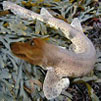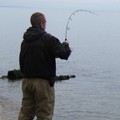Weavers
Moderator: donal domeney
-
stevecrow74

- Scomber Doorman
- Posts: 6928
- Joined: Fri Mar 05, 2004 4:26 pm
- Favourite Rod: ZippyProfile,IanGolds Premier Match
- Favourite Reel: penn 525 supermag extra
- Favourite Fish: the ones i catch
- Location: right behind you!!
- Has thanked: 34 times
- Been thanked: 47 times
caught enough of them, but thankfully never been caught out by one of them, from what i've heard it can be bad, very bad. And depending on how you react with one it could be very serious even life threatening... :shock:
supposed to be like 50 bee stings in one spot :shock: :shock: :shock:
supposed to be like 50 bee stings in one spot :shock: :shock: :shock:
[url=http://galwaybuccaneerssac.com/]Galway Buccaneers SAC[/url]
[i][color=red]St Juniper once said; 'By his loins shall ye know him, and by the length of his rod shall he be measured.'[/i]
[i][color=red]St Juniper once said; 'By his loins shall ye know him, and by the length of his rod shall he be measured.'[/i]
-
bovenip
- SAI Bait Ball
- Posts: 77
- Joined: Wed Jan 25, 2006 3:37 pm
- Location: Dublin 18
When we were kids my Mother was stung by a weever on Brittas Bay beach. We were fishing for bass and she figured she'd hooked a small whiting (which is so easily done) and brought it too hand. The following 3 or 4 hours were crazy for her - the whole hand swelled and went scarlet red. I had read to keep the affected area in water as hot as you can stand so thats what she did, but I don't remember it as being that much of a relief for her.
The next day its was still ridiculously swollen but not as sore. I think it took a few days for the swelling to completely subside.
After that experience, I double check any small fish I'm unhooking - its not something I'd like to go through!
The next day its was still ridiculously swollen but not as sore. I think it took a few days for the swelling to completely subside.
After that experience, I double check any small fish I'm unhooking - its not something I'd like to go through!
http://www.dinglefishing.com
-
pollocks!
- SAI Lug Worm
- Posts: 49
- Joined: Fri Nov 04, 2005 7:15 pm
- Location: south Kilkenny
- Been thanked: 1 time
When I lived in the USA I worked in an aquarium and was stung by a Lionfish while cleaning a tank. I can confirm that it hurt like hell. My one and only journey in an ambulance to the hospital. Hand swelled up, felt very sick. I got an antibiotic and a painkiller and was able to work the next day. It is true that you should put the infected ('stung')area into as hot a liquid as soon as possible as this breaks down the toxins.
-
teacher

- SAI Megalodon!
- Posts: 2417
- Joined: Sun Mar 19, 2006 2:18 pm
- Location: North Wexford
Just in case you can't get to some hot water quickly, I always keep one of those miniature first aid bags in by fishing bag with some pain killers, which are supposed to have some effect on weaver stings. Antihistamine is supposed to be useful for weavers too, but it never occurred to be (before now) to carry some of that too.
If I did get stung and happened to be on my own, the first thing I'd try to do is ring someone and tell them where I am ...
If I did get stung and happened to be on my own, the first thing I'd try to do is ring someone and tell them where I am ...
-
x
The poison denatures at 40 centigrade and over, so no point absolutely scalding yourself. Keeping the infected area in water just over 40 degrees for a while will neutralise most of the poison - it'll have done some damage as it went in but hopefully the heat will denature it before it spreads too far.
One thing that might be more practical to carry than a sinkful of hot water are the heat-packs most camping shops sell. A decent over the counter oral antihistamine is also easily carried - a couple of doses with a paracetamol (observe dosage as per manufacturer's recommendations) chaser over the next day or so should take the worst of the ouch out of it.
Never seen one in the NW, fortunately. Hopefully they can't hack the climate here. Can barely stand it myself...was in Portugal this time last year and it was in the mid to high 20's every day.
A piece of particularly useless information is that marine biologists theorise that the black tip on a black sole's pectoral fin may be a defense mechanism which works by making it look like a weever's dorsal spines.
One thing that might be more practical to carry than a sinkful of hot water are the heat-packs most camping shops sell. A decent over the counter oral antihistamine is also easily carried - a couple of doses with a paracetamol (observe dosage as per manufacturer's recommendations) chaser over the next day or so should take the worst of the ouch out of it.
Never seen one in the NW, fortunately. Hopefully they can't hack the climate here. Can barely stand it myself...was in Portugal this time last year and it was in the mid to high 20's every day.
A piece of particularly useless information is that marine biologists theorise that the black tip on a black sole's pectoral fin may be a defense mechanism which works by making it look like a weever's dorsal spines.
-
x
-
Esox lunatic
I have only encountered one weaver while shore fishing and it's probably no surprise that they get a bit tetchy with anglers!
[img]http://i3.tinypic.com/wjdll5.jpg[/img]
On a slightly more more practical note:
In the event of a weaver fish sting, the first aid which should be given is: clean the wound and immerse the affected part of the body for at least 30 minutes in water which is as hot as the victim can tolerate (40-45 degrees C).
[img]http://i3.tinypic.com/wjdmdd.jpg[/img]
There are probably three mechanisms at play. First, heat denatures the venom in the sting, which therefore becomes ineffective. Secondly, blood flow to the area is increased, removing the toxin from the tissues more quickly. Finally, the heat utilises the gate-control theory of pain, in which an alternative sensory signal or stimulus will block pain in a similar way to the relief found when scratching an itch.
E.L.
[img]http://i3.tinypic.com/wjdll5.jpg[/img]
On a slightly more more practical note:
In the event of a weaver fish sting, the first aid which should be given is: clean the wound and immerse the affected part of the body for at least 30 minutes in water which is as hot as the victim can tolerate (40-45 degrees C).
[img]http://i3.tinypic.com/wjdmdd.jpg[/img]
There are probably three mechanisms at play. First, heat denatures the venom in the sting, which therefore becomes ineffective. Secondly, blood flow to the area is increased, removing the toxin from the tissues more quickly. Finally, the heat utilises the gate-control theory of pain, in which an alternative sensory signal or stimulus will block pain in a similar way to the relief found when scratching an itch.
E.L.